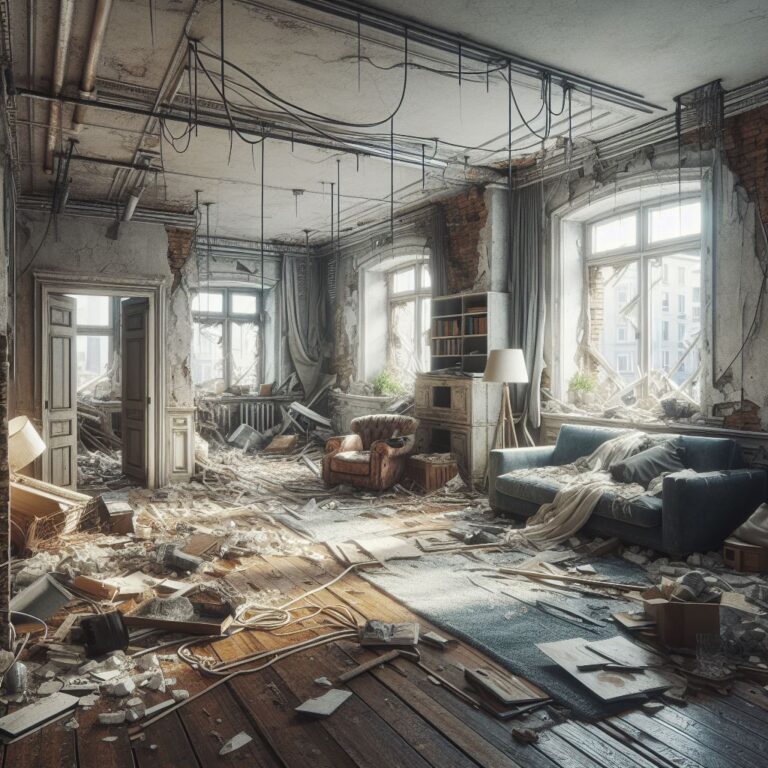In the aftermath of a catastrophic event that has rendered numerous homes uninhabitable, there is a glimmer of optimism as the journey towards recovery begins. Rebuilding and restoring these devastated homes may appear daunting, but with the right information and guidance, homeowners can embark on the path towards renewal.
This article aims to offer practical advice and step-by-step instructions to assist homeowners in assessing the extent of the damage, engaging with their insurance providers, and initiating the process of cleaning and disinfecting their homes.
Additionally, it will provide insights into overcoming specific challenges, such as addressing damaged mattresses and repairing ceilings, walls, and basements.
By adhering to these recommendations, homeowners can take the necessary measures to transform their devastated homes into beacons of hope for a brighter future.
Key Takeaways
- Contact insurance agent and arrange for an adjuster to assess damage
- Document damage with photos or videos before cleaning
- Clean all surfaces meticulously to avoid contamination
- Replace mattresses with new ones for clean and safe sleeping environment
Assessing the Damage and Contacting Insurance
The first step in the recovery process after devastating homes is to assess the damage and contact the insurance company. Homeowners should promptly call their insurance agent to arrange for an adjuster to assess the extent of the damage. It is important to document the damage with photos or videos before cleaning, as this will serve as evidence for the insurance claim.
Additionally, homeowners should ensure that they have flood damage insurance coverage, as standard policies may not cover this type of damage. When meeting with the adjuster, it is crucial to provide them with all necessary information and documentation.
Throughout the claims process, homeowners should cooperate fully with their insurance company to ensure a smooth and efficient recovery.
Removing Mud and Dirt
First, remove mud and dirt from the affected areas of the home. Use a garden sprayer or hose to wash away mud, dirt, and grime from hard surfaces. Clean all surfaces meticulously to avoid contamination. Scrub surfaces thoroughly with a heavy-duty cleaner, hot water, and disinfectants to remove remaining dirt or contaminants. Dispose of mud or dirt properly to prevent further damage or contamination.
To create a vivid mental image, here is a table depicting the process of removing mud and dirt:
| Steps to Remove Mud and Dirt | ||
|---|---|---|
| 1. | Use garden sprayer or hose | Wash away mud, dirt, and grime from hard surfaces |
| 2. | Clean surfaces meticulously | Avoid contamination |
| 3. | Use heavy-duty cleaner, hot water, and disinfectants | Remove remaining dirt or contaminants |
| 4. | Scrub surfaces thoroughly | Ensure cleanliness |
| 5. | Dispose of mud or dirt properly | Prevent further damage or contamination |
Disinfecting and Cleaning the Kitchen
After removing mud and dirt from the affected areas of the home, it is essential to proceed with disinfecting and cleaning the kitchen. Here are five important steps to follow in order to effectively clean and disinfect your kitchen:
- Remove all food items from the kitchen and discard any that have come into contact with floodwater.
- Thoroughly clean all surfaces, including countertops, cabinets, and appliances, using a heavy-duty cleaner and hot water.
- Use a strong sterilizing solution to soak porcelain, glass, china, and enamelware.
- Disinfect surfaces by mixing chlorine bleach with hot water and applying it vigorously. Let it sit for at least 10 minutes before rinsing.
- Avoid using chlorine bleach on silverware, pots, pans, and metal utensils. Instead, boil metal utensils in water for at least 10 minutes to ensure proper disinfection.
Dealing With Damaged Mattresses
To effectively address the issue of damaged mattresses in the aftermath of a flood, it is imperative to promptly discard all unsalvageable mattresses and replace them with new ones for a clean and safe sleeping environment. Floodwaters can contaminate mattresses with bacteria, mold, and other harmful substances, posing health risks to individuals who continue to use them. It is important to prioritize the safety and well-being of occupants by investing in new mattresses.
Additionally, considering the purchase of waterproof mattress protectors can help prevent future damage in case of any future floods. It is advisable to consult professionals for proper disposal methods of damaged mattresses to ensure compliance with environmental regulations. Taking these necessary precautions will contribute to a healthier and safer living environment.
Repairing Ceilings, Walls, and Basements
In addressing the issue of repairing ceilings, walls, and basements, it is crucial to hire a professional to handle the repair of soaked wallboard, paneling, and plaster, as these materials can pose serious health hazards if not properly treated.
Here are five important steps to consider when repairing ceilings, walls, and basements after a flood:
- Pump out at least two to three feet of water from the basement daily.
- Drain the basement slowly to prevent damage to floors and walls.
- Address cracks or structural issues in walls and floors to ensure safety.
- Remove any wet wallboard, paneling, or plaster to prevent mold growth.
- Hire a professional to repair and restore the damaged areas using appropriate materials and techniques.
Taking Precautions for a Safe Recovery
With safety as the utmost priority, homeowners can ensure a secure recovery by implementing precautionary measures.
Firstly, it is crucial to assess the damage and contact the insurance company to arrange for an adjuster to assess the extent of the damage. Homeowners should document the damage with photos or videos before cleaning and ensure that their flood damage insurance coverage is in place. It is important to cooperate fully with the insurance company throughout the claims process by providing necessary information and documentation.
Removing mud and dirt requires thorough cleaning of all surfaces to avoid contamination. Disinfecting the kitchen is essential, using sterilizing solutions and disinfectants. Damaged mattresses should be discarded, and new ones should be purchased to ensure a clean and safe sleeping environment.
Hiring professionals to repair soaked ceilings, walls, and basements is recommended, as wet materials can pose serious health hazards.
Frequently Asked Questions
How Long Does It Typically Take for an Insurance Adjuster to Assess Flood Damage?
On average, it typically takes an insurance adjuster a few days to a week to assess flood damage. However, the exact timeframe can vary depending on the severity of the damage and the workload of the adjuster.
Are There Any Specific Cleaning Products or Disinfectants Recommended for Removing Mud and Dirt From Hard Surfaces?
When removing mud and dirt from hard surfaces, it is recommended to use a heavy-duty cleaner, hot water, and disinfectants. Scrub surfaces thoroughly to remove remaining dirt or contaminants and dispose of mud or dirt properly.
What Are the Potential Health Risks Associated With Using Chlorine Bleach on Certain Kitchen Utensils?
Chlorine bleach can cause damage to silverware, pots, pans, and metal utensils when used in the kitchen. It is recommended to avoid using chlorine bleach on these items and instead opt for boiling metal utensils in water for disinfection.
Is There Any Way to Salvage Mattresses That Have Been Damaged in a Flood?
Unfortunately, mattresses damaged in a flood are unsalvageable and should be discarded. It is important to replace them with new ones to ensure a clean and safe sleeping environment. Proper disposal methods should be consulted with professionals.
What Steps Should Be Taken to Address Structural Issues in Walls and Floors to Ensure Safety?
To address structural issues in walls and floors after a flood, it is imperative to hire a professional. They can assess the damage, repair soaked wallboard, paneling, and plaster, and address cracks or other issues to ensure safety.






